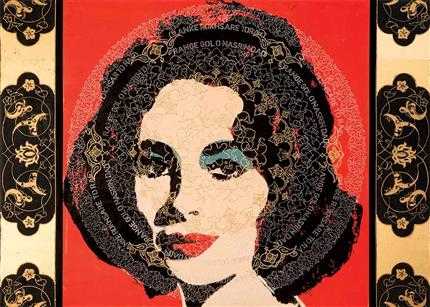About Mahmood Sabzi
Despite some theoretical contradictions, Mahmood Sabzi's paintings can be considered a native version of pop art. In addition to these well-known works, he has also had experiences in abstract expressionism and lyrical figurative paintings. Sabzi was born in Hamedan and migrated to Ahvaz with his family. He was interested in painting since childhood, but he pursued his university education in agricultural engineering and received a bachelor's degree from Ahvaz Jondishapour University. His first career had a realistic tone. His life in Ahvaz coincided with the 8-year war, and this issue left a profound impact on his mentality and art. He volunteered on the battlefield and later created designs on the theme of war legacy and displacement of war victims. It was the fifth year of the war that he immigrated to Germany, went to the United States, and settled in southern California. Sabzi held the first solo exhibition of his works in 1999 at the Wind Gallery in Japan. In 2007, he exhibited a collection of his "First Impression" paintings at the Palm Harbor Gallery in Florida. In the continuation of his artistic career, he has held numerous exhibitions in the art centers of the United States, France, England, and Japan. In 2011, after the long-term absence of this artist from the artistic spaces of Iran, he held his first solo exhibition at Azad Art Gallery and has continued his collaboration with this gallery until today.
In his paintings, he mixes elements of pop art with motifs belonging to the tradition of gilding and Iranian-Islamic calligraphy. On the one hand, these motifs are decorative and contain native colors. On the other hand, combining these traditional elements with the modernist background gives a paradoxical character to his paintings. In some of his paintings, he uses the famous works of Andy Warhol, such as the Marilyn Monroe and Marlon Brando paintings, and places decorative elements such as the Shamseh as a seal of tradition in the foreground. Although this usage may seem sloppy, it is consistent with the central ideas of Pop Art. However, pop art is not an accurate title for Sabzi's works.
Contrary to the principles and basics of pop art, he does not use the elements of native folk art as the basis of his works, and he borrows the Persian aspect of his work from tradition. In some other Sabzi paintings (in line with many artistic movements of recent years), portraits of court women and men are used. He also frames these picture collages with decorative borders. Finally, in both groups, Sabzi has a formal impression of the artistic tradition, which contains exotic and touristic content. Sabzi has also had experiences in abstract painting in parallel with the works mentioned above, which are reminiscent of abstract expressionism. In this series of his paintings, he puts a variety of gray colors on the surface of the canvas, like a stormy and twisted mass. Some of his other paintings are generally romantic and lyrical images with a mood similar to Matisse's paintings in color scheme and interest in embellishment.
The Most Expensive Artwork
At Auctions
First Attendance
18 April 2012
# Attendance
22
# Artworks
23
Average Realized Price
4,845 USD
Average Min Estimate
3,006 USD
Average Max Estimate
4,236 USD
Sell-through Rate
82.609%
Average Growth of Artwork Worth
-10.327%
Timeline
Modern Art, Pottery, & Jewelry - Day 1 auction
7 June
FINE FOLK OUTSIDER auction
18 November
Blossoms & Brushes: Celebrating Art in May auction
11 May
Jewelry, Furniture, Fine Art, Asian Art auction
14 August
Memorial Holiday auction
26 May
Paintings, Furniture, Decorative Arts, & Fine Rugs auction
24 July
Fine Art and Fine Jewelry auction
23 May
Paintings, Furniture, Decorative Arts & Fine Rugs auction
8 February
دوازدهمین دوره حراج تهران auction
17 January
November Estate Art And Antiques auction
16 November
Holiday Auction Extravaganza auction
6 February
Wonderful Original Art, Designer Watches and Jewelry Auction auction
20 November
Fall Estate Antiques and Modern auction
14 October
The 6th Tehran- Contemporary Iranian Art auction
23 December
Between Memory and Dream exhibition
13 May
چهارمین دوره حراج تهران auction
29 May
Going Nowhere exhibition
16 January
سومین دوره حراج تهران auction
30 May
I Am Lost exhibition
11 October
Ayyam - Dubai - September 2013 auction
16 September
The Young Collectors - Art from the Middle East auction
30 April
Modern & Contemporary Arab, Iranian and Turkish Art Part II auction
24 October
The Young Collectors : Art from the Middle East auction
22 October
Modern and Contemporary Arab, Iranian and Turkish Art Part II auction
18 April
The End of Purity exhibition
9 September
